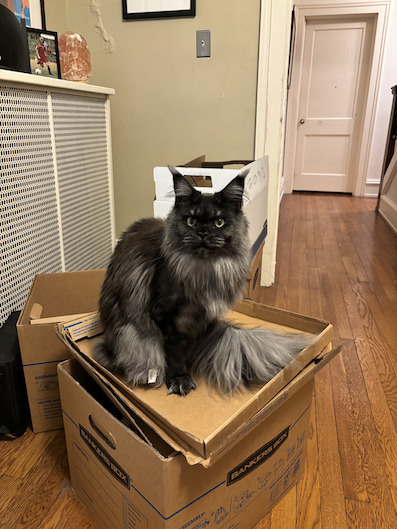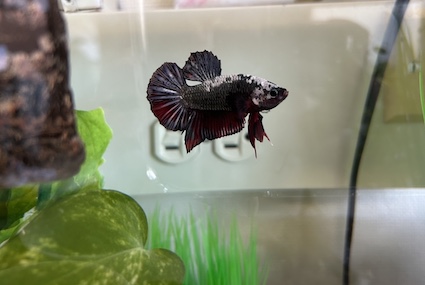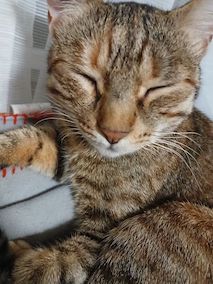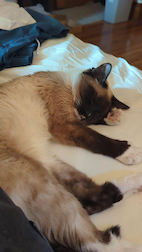
Pet: Xanthus
c/o Laurence Smyers

Pet: Pork
c/o Madeleine Metzger
For most, bringing pets into student housing earns a $300 fine and a referral to the Community Standards Board. However, for many at the University, approved animal companions, officially referred to as emotional support animals (ESAs), provide irreplaceable comfort, and are the cornerstone of community bonding. As students round off the first month of classes, this inseparable connection makes navigating schedule challenges and spatial changes worth it for campus pet owners.
“I definitely think having a more spacious living situation on campus would help [pet owners],” Andy Lisheng ’25, who has a spry half-Siamese cat named Ashe, said. “I got lucky with her because she’s not a very picky or hard-to-adjust kind of cat.”
In contrast, this adjustment is difficult for pets in large underclassmen dorms, where proximity to potable water, pet waste disposal sites, and quiet refuge areas varies widely between floors.
“She really doesn’t like Butts as an environment,” Laurence Smyers ’28, who owns a smoke-gray Maine Coon named Xanthus, said. “The other thing is that the stairs are really rusty. That’s not an issue if you wear shoes. Xanthus doesn’t wear shoes.”
Still, first-year students find creative solutions to confined housing situations. Becoming comfortable relying on others nearby can be a crucial factor in successfully juggling pet-related obligations.
“It was hard to take care of him at first, because you have to carry the tank to the sink,” Madeleine Metzger ’25, whose beloved Betta fish Pork sadly passed away last summer, said. “I used to trap any man I saw in the hallway that I thought was cute, or I wanted to talk to, [to] carry the tank to the sink. That was my move freshman year.”
Dorm pets might make quality wingmen, but their social benefits are twofold. Animals encourage their owners to spend time outdoors, while emboldening strangers to introduce themselves. Lisheng recalls Ashe’s magnetism during his junior year.
“Back in our old house, I had a really small room, so that was quite a big problem,” Lisheng said. “I didn’t let her go out too much, but she did make a couple of appearances from the window. People liked to ask, ‘Oh, who’s there? This cat is there?’ They just like to see cats. Because cats are cats.”
Pets can spark curiosity and foster connections between students who may never otherwise interact. Even watching wild animals around campus sparks joy for many.
“I get happiness watching a squirrel with a nut,” Layth Meah ’28, who lives in a wood-frame with his family and boisterous rescue cat, Nala, said. “So having a cat definitely can spark things up. It makes things a little bit brighter.”
Having an animal companion means enjoying a deeply meaningful and judgment-free friendship. This is the core of what ESAs, like Ashe and Xanthus, are certified to provide. Unfortunately, some struggle to grasp the gravity of the role these pets play in maintaining their owners’ mental health.
“One assumption I’ve come across is people thinking that the fact that she’s an ESA is really just an excuse, so I can have a cat on campus, which I promise is not the case,” Smyers said. “And I do joke and sometimes say that she has a job, which is funny because she has zero awareness of having a job. But she really does do a lot for me, and she is really there for a real reason.”

Pet: Nala
c/o Layth Meah

Pet: Ashe
c/o Adam Lisheng
Of course, ESAs are not the only pets on campus subject to assumptions and misunderstandings that their owners would happily debunk.
“People tend to think that, ‘Oh, it’s cute, blah, blah,’” Lisheng added. “I mean, she’s really cute. But a lot of effort goes into taking care of someone, an entire living being. And it’s good to be aware of their needs as much as your needs too, right? Because with the emotional support, you’re also supporting each other.”
After detailing her extensive efforts to ensure Pork a luxurious life, Metzger expressed dismay concerning the lack of appreciation for pet fish.
“A lot of college fish are kind of tortured and kept in alcohol bottles, and that was just really not what I wanted,” Metzger explained. “I think that was why he lived so long, just because I took really good care of him.”
Metzger continued to stress the importance of proactively caring for pets that cannot speak up for themselves.
“I think a fish is seen as a really low maintenance, easy pet to get in college,” Metzger said. “But I think they’re really easily neglected just because they’re not in your face all the time. Fish can’t talk, or meow, or anything, so I think people don’t get it.”
Despite those misconceptions, Pork was anything but passive in Metzger’s social circles. Pork’s life of adventure and popularity exemplified the impacts of pets on student groups.
“I think it does establish a sense of community,” Metzger said. “And everyone who came over would always go say hi to Pork. That was our introduction: ‘Oh, did you see Pork?’ And then even when he died, I had a little Zoom shiva for him, and I was very surprised by how many people came. Someone came in a suit.”
When a community grows alongside a pet, relationships of reciprocity come naturally. People are happy to have something positive to rally around and care for together.
“Wesleyan students, they’re genuinely some of the friendliest people,” Meah said. “They don’t know me, so I try to give something back, let the cat out, make them happy.”
Hope Smith can be reached at hnsmith@wesleyan.edu.
Comments are closed